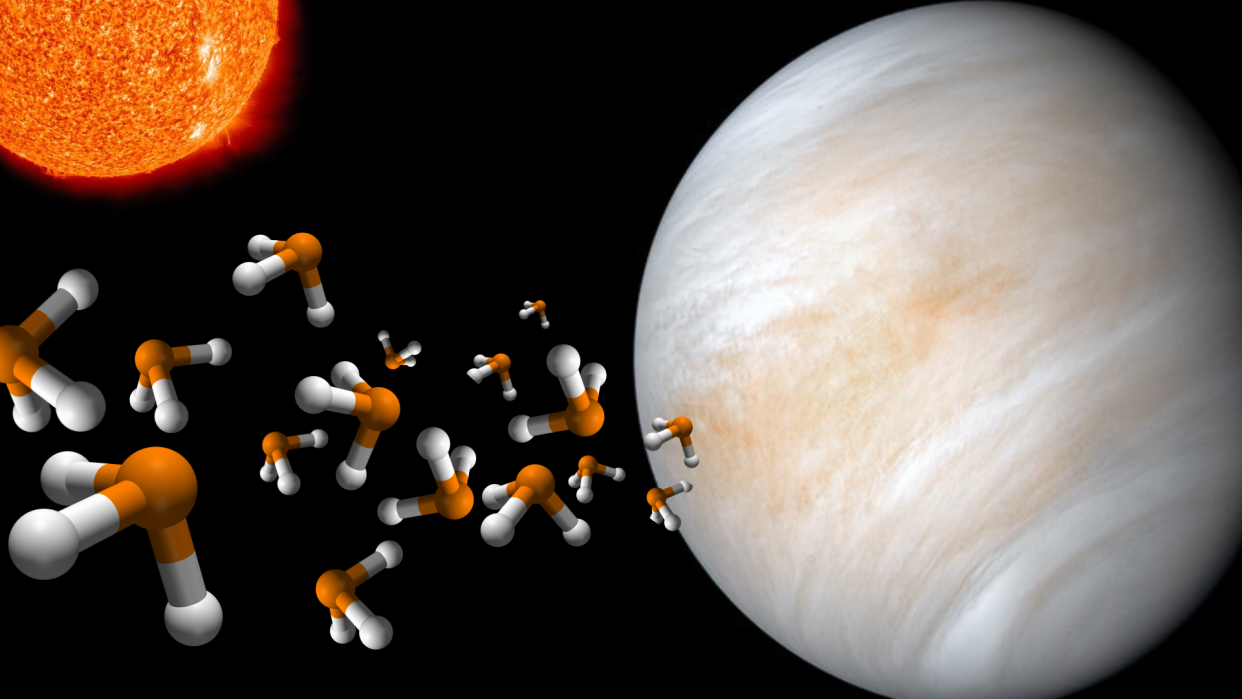Life on Venus? Intriguing molecule phosphine spotted in planet's clouds again

The Venus phosphine saga continues.
In September 2020, a team of scientists led by Jane Greaves of Cardiff University in Wales reported the detection of phosphine, a possible indicator of life, in the clouds of Venus. The announcement sparked a heated debate and a surge of follow-up studies, which have generally failed to spot the intriguing molecule in the Venusian atmosphere.
Now there's a new twist. Speaking at the Royal Astronomical Society's National Astronomy Meeting 2023 in Cardiff this week, Greaves revealed the discovery of phosphine deeper in the atmosphere of Venus than it had been spotted before. Using the James Clark Maxwell Telescope (JCMT) at the Mauna Kea Observatory in Hawaii, Greaves and her colleagues delved into the atmosphere of Venus, down to the top and even the middle of the planet's clouds.
The team thinks that the phosphine could be coming from lower in Venus' atmosphere. But, as Greaves pointed out in the talk, the real question is, What does the phosphine mean? Could it be evidence of alien life on Venus?
Related: The phosphine discovered in Venus' clouds may be a big deal. Here's what you need to know.
Greaves said that, on Earth, phosphine is generated by microorganisms living in a very low-oxygen environment. She explained that phosphine is generally not made in other ways on our planet, as Earth lacks an abundance of "loose" hydrogen. This suggests that phosphine, if detected on other worlds, is a potential biosignature.
That's why the putative Venus phosphine find caused such a stir three years ago. And the thought of life on Earth's "sister planet" isn't as far-out as you might think: While Venus' surface is incredibly inhospitable, reaching temperatures around 900 degrees Fahrenheit (475 degrees Celsius), conditions about 30 miles (50 kilometers) up in the clouds are much more temperate and Earth-like.
However, even if there is phosphine in the Venusian atmosphere, it doesn't necessarily mean the planet hosts life. Abiotic processes, some of which we don't fully understand, could also be generating the stuff on Venus.
"There’s a big school of thought that you can make phosphine by lobbing phosphorus-bearing rocks up into the high atmosphere and kind of eroding them with water and acid and stuff and getting phosphine gas," Greaves said during her talk.
2020: When all hell broke loose on Venus
Greaves may be wary of sparking a furor like the one that resulted from the initial detection of phosphine by her team three years ago.
She reflected on how the search for phosphine in the atmosphere of Venus was prompted and how that led to the 2020 situation. She said the decision to investigate Venus resulted from the study of other solar system worlds like Saturn and improved telescope technology that allowed for the probing of the atmospheres of smaller planets.
"I vaguely remembered Venus is supposed to have this potential habitat in the high clouds, which is anaerobic, and we eventually got telescope time, so I thought, 'Why don’t we have a very quick look and see if there’s some phosphates in Venus clouds, an analog to things living on the surface of the Earth?'" Greeaves said. "Astonishingly, we found it, and all hell broke loose!"
The potential detection sparked a flurry of follow-up research, some of which was conducted by teams consisting of scientists involved in the initial phosphine detection, that failed to turn up the molecule. And these new findings from Greaves and her team are likely to prompt even more follow-up investigations.
The debate could be settled in the not-too-distant future, for Venus has emerged as a planetary science and astrobiology priority. For example, two NASA missions, called VERITAS and DAVINCI, and Europe's EnVision orbiter are scheduled to launch toward the planet in the next decade. DAVINCI will carry a descent probe, which will study the Venusian atmosphere up close as it plunges through it.
